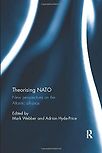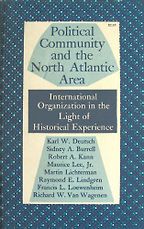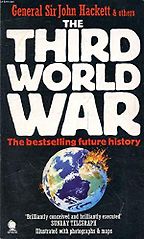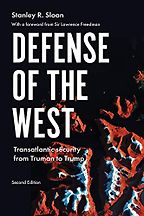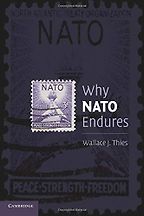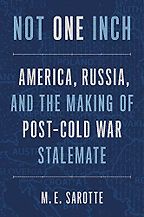Thank you for selecting five of the best books on the North Atlantic Treaty Organisation, the body commonly known as NATO. I think you want to make clear that this is a reading list aimed at the common reader: an intelligent lay person.
If I were setting a syllabus for, say, a summer school on NATO, I would probably have chosen different texts. But these are for someone who wants to read for enjoyment and understanding.
Agreed. Now, given the backdrop to our conversation, the ongoing war in Ukraine, it seems a good time for people to examine what NATO is, exactly, and its history. Would you give us a concise introduction?
The fourth of April was the 73rd anniversary of the North Atlantic Treaty, which is the basis upon which NATO as an organization was formed. The treaty was signed in 1949, among a much smaller number of countries than the 30 members of today. Just 12 originally: the United States, Canada, and countries in western Europe. NATO was created in order to deal with what was regarded as the threat of Soviet Communism.
At that point, the division of Europe was already pretty evident. So NATO’s mission, in some ways, was very clear cut for the following 40 years, during the Cold War. It was determined to fend off the possibility of Soviet aggression and destabilisation against Europe. And not just western Europe, but also Turkey and Greece in the south. Some of the early crises were to do with Turkey and Greece. But the main concern was Germany, the division of Germany and the possibility of Soviet ambition against West Germany—and, to a lesser degree, NATO allies like Italy and Norway.
NATO, in a sense, consolidated western defence, with an American and Canadian guarantee of west European security. Within a year of the treaty being signed, the Korean War happened, which gave a shot in the arm to the need of bringing things together within a permanent structure. So, as they say, the ‘O’ in NATO—the organisation—was formed a year after the treaty with the consolidation of a series of committees, a command structure, and a strategy and military doctrine.
“Without NATO as a framework, the individual efforts of the allies would be less effective”
That remained pretty much the picture for the next 40 years. There was quite a lot of discussion about the intricacies of nuclear strategy and conventional deterrence. NATO acquired very few new members during the Cold War—Greece, West Germany and Turkey in the early 1950s; Spain in the mid-1980s—but the division of Europe was solid and it seemed like the Cold War would last forever.
There was a period in the 1970s that became known as ‘détente’, when the NATO powers negotiated with the Soviet Union and the Warsaw Pact tried to consolidate and stabilise the situation. We then get to the late 1970s and things started to deteriorate. The Soviet Union at that point was regarded as more aggressive than it had been in the 1960s and 1970s. It was very influential and invaded Afghanistan in 1979. It increased its nuclear arsenal.
On the western side, Thatcher and Reagan tried to match that, and there was a new arms race. There was a lot of worry around that time about nuclear escalation. This was the period in which anti-nuclear protest became much more widespread. This period became known as the so-called ‘second Cold War’. The division between East and West deepened.
And then Mikhail Gorbachev came to power in 1985 and we had a six-year period in which NATO and the Soviet Union agreed a series of steps that ended the Cold War; but then the Cold War also ended in part by accident because of the fall of the Berlin Wall and the collapse of the Soviet Union.
At that point, people thought: well, that’s NATO done. Mission successful. The Soviet Union, and the Warsaw Pact have disappeared, the threat of Communist expansionism has gone. China was nowhere near as significant then as it is now. But NATO continued largely because the Americans, British and Germans were very keen that NATO remain the anchor of European stability. It then acquired new missions: peace-keeping in the former Yugoslavia in the 1990s; the global ‘war on terror’ after 9/11, hence the very long mission in Afghanistan.
And then, from 2014, with the Russian resurgence, the annexation of Crimea, right up to the current problem in Ukraine, NATO has returned in some ways to its roots, which is deterrence against Russia. So, sorry, this has not been concise. But in essence, NATO is a military alliance, which has survived now for much, much longer than was originally anticipated. It has grown in membership, grown in the functions it performs. And for its members, it retains a contemporary relevance; it is by far and away the most significant and institutionalised alliance that exists anywhere in the world, and for the United States probably the most reliable alliance it can call upon in foreign policy.
Get the weekly Five Books newsletter
One further thing—and this will be highlighted in the books in a moment—that’s interesting about NATO, is that it’s a political alliance as well as a military one. Alliances are normally brought together for the needs of the moment. The transatlantic alliance in the Second World War and the ‘coalition of the willing’ brought together for the Gulf Wars, had a very narrow set of military objectives. But NATO, from the beginning, had aspirations towards political community. That was overshadowed in Europe by the formation of what would become the European Union. But there is a very important strand of political cooperation in NATO as well, which I think often goes unseen, but in some ways is very important.
It largely explains what’s going on now in Ukraine. If NATO did not have shared political sentiments, it couldn’t have reacted in the way it has over Ukraine—that solidarity. The manner in which the United States has been able to lead the alliance in supporting Ukraine has been brought together because there was already decades of established habits and cooperation, which the NATO allies can call upon.
What we have is almost one-of-a-kind. There are many, many different international organisations in the world, and quite a lot of them are unique. There’s nothing quite like the EU, either, but there are many alliances. NATO, however, is quite different in its sophistication and its political objectives. It’s been going for 73 years, and has been involved in many different types of operation—terrorist defense, peacekeeping, the alleviation of the climate crisis, and so on. That’s it in a nutshell, although I appreciate you couldn’t fit that all in a tweet.
I think that sets us up just beautifully. You mentioned that political elements have been sewn into NATO from the start. Perhaps we could talk first about Political Community and the North Atlantic Area by Karl Deutsch and others? This is quite an early book, published in 1957. Princeton Legacy Library will print copies on demand. In an earlier email, you described it to me as a book of “enduring insight”—how so?
This is a book that has had an enormous influence over how scholars think about NATO, and indeed about the countries that make up NATO. Its great benefit is that it’s very accessible, even though it’s clearly aimed at an academic audience.
It makes an argument, which at the time was part of a movement called Neo-Functionalism, which is the idea that states cooperate: that they have a shared economic, or political, or cultural interdependence. There was a great attempt at the time to measure this stuff through trade, movement of population, and—before the internet—things like the movement of mail.
So Deutsch and others were Neo-Functionalist in the sense that they tried to measure how the countries in western Europe were coming together, and the prospects over time for them to become what they referred to as a ‘security community’ as well as a political community. A security community is something that seems intuitively straightforward: this is a group of countries that do not go to war with one another. Nor do they plan to do so. So their foreign policy is therefore quite predictable when they face off against one another.
Now, in 1957, this was not an easy thing to say. It was only 12 years after the Second World War. It was partly a prediction, partly measuring existing trends. But to come forward with the idea that France and Germany were part of an emerging security community was quite a novel argument to make, given that they had been involved in two World Wars and also the Franco-Prussian war in the 19th century.
So that was the big idea. Then it sort of disappeared for three decades, and the idea of the security community was revived in the late 1990s, in another very influential book simply called Security Communities, in which Deutsch was rediscovered. People re-read it, they found in it a whole load of arguments about the importance of shared identity. So rather than national identities getting in the way of cooperation, Deutsch came up with this idea of what we called ‘we feeling’; that we regard each other as a ‘we’, not ‘you’ and ‘I’. That came about through cultural movements. The states had similar political systems. They were economically interdependent.
This idea moves us beyond simple Neo-Functionalism to argue that some deeper cultural identity could be formed over time. And so states don’t go to war with each other—and not just because it’s bad for business. They don’t go to war with each other because they are increasingly empathetic towards one another.
Later there would be a strand of theorising in international relations called Social Constructivism, which was very influential in the 1990s and the first decade of this century. Social Constructivism was all about the importance of ideas and norms and identity. But Deutsch sort of got there 30 years before everybody else, although sadly he wasn’t recognised for it at the time and had passed by the time his ideas became influential.
“A security community is a group of countries that do not go to war with one another. In 1957, this was not an easy thing to say”
Now, NATO is very important in all of that, because the security community in the North Atlantic area, becomes institutionalised in NATO. So NATO has a very important role in facilitating the growth of that community through institutional procedures, where states come together in effect on a weekly or even daily basis to discuss their defence and military needs.
But remember what I said earlier—also their political issues. NATO made a very deliberate effort in the 1950s to try to talk through things like the Cyprus crisis between Greece and Turkey. They tried, but didn’t get very far, in discussing economic cooperation. In the late 1960s, they started discussing scientific cooperation. All of this was a conscious effort to bring together an idea of political community, which would sit next to the military alliance.
Now, the people doing this in NATO, of course, hadn’t read Deutsch. But what they were doing was an affirmation of what Deutsch had theorised. So for me it’s a very interesting and influential take on NATO as an institution, and the much broader political, geographic, economic world of which it is part. It makes real some of the claims, which many people dismiss as rhetoric, around the time NATO was formed.
It’s been 65, almost 70, years since it was published, and much of what he anticipated has come to pass. Not all of it. But the depth of political and security community is, I think, a vindication of his very insightful way of looking at things.
I say ‘him’. It was not only him. The front piece of the book has another seven authors, so it was a team effort. But Deutsch was the lead author, and it has proven, as I said, enduring and very, very influential. I think anyone who wants to seriously understand transatlantic relations, and the durability of NATO, needs to read this.
Thank you. I should note that a number of universities also seem to have digitised key sections, so parts are also available online. Now, I’m very intrigued by your second book choice, The Third World War: A Future History by General Sir John Hackett . It’s a dramatised prediction of how a nuclear World War might unfold, and today—its ‘future’ now long past—it serves, essentially, as a work of alternate history.
Let me make a small digression. I first read this in a tent at Land’s End in 1979. I was on a walking holiday with a friend in the days before mobile phones. We got to Land’s End a day before my father was due to come and collect us. It was pouring with rain and, with nothing else to do, I bought this in a bookshop. I read it literally in a day. I couldn’t put it down. And I’ve re-read it since.
One of the reasons I think this book is still worth reading, even though it’s now well out of date, is that, firstly, it’s probably still one of the very best examples of a whole genre of books where a war is imagined, and how it would happen. There’s a contemporary book by General Sir Richard Shirreff, a very high-ranking British military officer just retired, who wrote a book called 2017: War with Russia, which is about a Russian invasion of Ukraine and how that drags in NATO.
Oh really.
And in that, he himself pays respect to John Hackett, who imagined this way of thinking before. There are several books of this sort, in which a World War occurs, and people with expertise imagine how it might play out.
Mostly though, I mean, it’s gripping. It’s very convincing as well—thinking back to the circumstances when it was written. You could well imagine the developments he describes actually occurring. He explains how in the Soviet Union there was a deliberate provocation against the NATO powers in Europe. In addition, Soviet sympathetic states around the world in Africa and Latin America are also prompted to undertake action against western interests. So you have, taking off all at the same time, a war in Yugoslavia, a war in southern Africa, a war in the Gulf, and then a Warsaw Pact invasion of West Germany. It calls NATO into action.
The reason it’s particularly good on NATO is that all the dry description you might find in an academic or military publication about nuclear strategy—conventional deterrence, the different ways in which the Allies would interact—is all brought to life. He describes the manner in which British, French, German, American, Canadian, Dutch, Danish, Norwegian forces are mobilised. Effectively, NATO wins, but it’s pretty ugly.
I work in Birmingham, England; unfortunately, in this book, there’s a nuclear strike against Birmingham. Then NATO, through the US and UK, retaliate with a nuclear strike against Minsk in Belarus. And that leads to an end of the war. The Soviet Union admits defeat. And the nuclear strike against Minsk leads to a collapse of the Soviet Union, which was also very prescient because the Soviet Union did collapse, ten or so years after the book was written—though not through a nuclear strike, through internal division, which is partly explained here.
I could go on. It has some great descriptions about the way in which NATO works. Without NATO as a framework, the individual efforts of the alliance would have been much less effective in the aggregate. That’s a very good way of understanding NATO; the contribution of the allies, though incompletely coordinated, add up to far more than the sum of their parts.
So, even now, so many years after, it’s still a very enjoyable read even though the subject matter is pretty grim. One can learn a lot about the alliance and the circumstances in which it would have had to have fought in the Cold War.
Just briefly, on this question of nuclear strikes: at the beginning of NATO, nuclear deterrence was the main focus. But this idea of ‘massive retaliation’ has evolved over the years.
Yes, NATO’s nuclear doctrine was exactly as you said: massive retaliation—a single strike from the Soviet Union would give rise to a potentially devastating attack on the Soviet Union. There would be escalation very early. The idea behind that was to compensate for the Soviet Union’s conventional superiority. NATO had to make good on that imbalance through a nuclear doctrine that implied massive retaliation in order to deter the Soviet Union exploiting this superiority.
That changed in the mid- to late-1960s, because it was recognised that a massive retaliation against the Soviet Union would in turn lead the Soviet Union to respond in kind against the West. So it was mutual suicide.
The NATO approach became known as ‘flexible response’; in other words, the allies would seek to fight the Soviet Union first with conventional weapons, and would go nuclear if and when it was necessary. So let’s assume the Red Army, the Warsaw Pact, occupied all of West Germany, invaded France, occupied the Netherlands and Denmark and was threatening the UK. NATO may decide to go nuclear to prevent any further advance, but perhaps a small strike. It was flexible in the sense that the point at which nuclear weapons would be used was not specified, either at what point of the ladder of escalation and the extent to which it would occur.
I could bore you to tears with the doctrine that lay behind that, and the politics, because it was very controversial. West Germany saw this as a lack of resolve on the part of the United States. They wanted massive retaliation to stay as a sure sign that America was committed to the defence of West Germany. Others saw flexible response as a way by which the United States would fight a limited nuclear war in Europe. In other words, they would tolerate the destruction of Europe in order to save America from being hit by a nuclear weapon from Russia. And so on. So it was very controversial.
But what is interesting about it is that a version of flexible response is still NATO’s doctrine to this day. That hasn’t really changed. It can get quite nerdy, this sort of stuff, but it’s very, very important.
Okay. Your next NATO book recommendation is Stanley Sloan’s Defense of the West: Transatlantic Security from Truman to Trump. This was updated in 2020. You described it as “a one-stop book”?
Sure. I think one has to include in the five a book where the reader would find out everything the needed to know in one place, if they wanted a decent knowledge of NATO. There are three or four books that fit that bill. David Yost’s NATO’s Balancing Act. Lawrence S. Kaplan’s NATO Divided, NATO United. But both those books are at least ten years old, so don’t get much beyond the Obama administration in the United States and certainly don’t have Trump, which is important. Even this only gets as far as 2019. But there is no other book which is comprehensive as this, which takes on board the withdrawal from Afghanistan and the Ukraine war. No doubt in a few years’ time there will be a third edition. It is a sort of textbook. For the non-specialist, it would be the one book I would recommend in order to get a thorough grounding in the history of NATO, and how it works.
The key dynamic, Stanley Sloan argues, is how the United States and Europe have undertaken what he calls ‘the transatlantic bargain’ in order to keep NATO together. So the United States is the backstop for European security, as long as the Europeans try to contribute as much as they can to their own defense, and—in the early days of the Cold War—also their political stabilisation and economic integration.
It’s long, well-footnoted, very well written. Stanley Sloan himself is one of the most reputable scholars on NATO. Larry Kaplan, who sadly passed away a year ago at the age of 95, was probably the single best historian of the alliance, but I couldn’t find one book of his that would fit the bill. This one does.
After Donald Trump, are we now seeing a return to business as usual?
Yes. Trump was certainly an interlude. To be polite, Trump was different in all manner of ways. On NATO, very different, in that he publicly undermined the idea that the United States was committed to the alliance, and publicly criticised a lot of the allies. A lot of American presidents were very critical of the allies in private, and occasionally in public as well, but none had raised the prospect that the United States would actually withdraw from NATO.
To be honest, I didn’t actually take that threat seriously. A colleague and I wrote an article where we argued it was performative and inauthentic, and as it happens, the United States did stay in NATO throughout the Trump period. By the end, Trump was actually talking NATO up.
But if Trump was still in power, no, I cannot imagine NATO would have got its act together in the way it has over Ukraine; American leadership just would not have been there. So Trump was very damaging. As an aside, there are quite a lot of memoirs around the Trump period; John Bolton’s The Room Where It Happened, for instance. I could have picked a memoir, as there are some very good memoirs around the Trump period which go into the damage Trump did to NATO.
Your next book recommendation is Wallace Thies’ Why NATO Endures.
Wallace Thies also died recently, which was a great loss. He wrote this and another book on burden sharing, Friendly Rivals, and both are fantastic. This one is good on all manner of levels. It has a memorable title, and although it’s aimed at an academic audience it’s very well written and accessible. I really like this book, and it has been very influential in the way I regard NATO.
His key argument is that a lot of scholarship simply gets NATO wrong, because it assumes that NATO is always in crisis, and that that crisis is worse than anything that has gone before, and therefore NATO’s days are numbered. There’s a great sentence here: “Henry Kissinger owns the distinction of pronouncing the Atlantic alliance in serious trouble in all six decades of its existence. So it’s a critique of what he calls the ‘NATO in crisis literature’; he shows it’s wrongheaded. He provides examples of how particular episodes have been seen as a moment of crisis, but NATO survived.
Of course, NATO has faced crisis, and is often deeply divided. NATO will deal with a crisis like Bosnia or Kosovo or Libya or Ukraine. But just because NATO is dealing with a crisis, and to some degree may be divided over the crisis, you shouldn’t then leap to the assumption that that means the organisation is suffering some sort of fatal endpoint to its existence. Thies argues that NATO, even when divided, has this ability to self-repair.
Five Books interviews are expensive to produce. If you're enjoying this interview, please support us by donating a small amount.
That’s because—but pretty much all—its membership has been for a long time democratic. So, the allies in their relationships with one another, are open to debate, are capable of arguing about one thing really quite bitterly but still cooperating on another. The allies basically elevate to the international level what goes on at the domestic level. In domestic politics, we argue all the time. But it doesn’t mean the government or the state is about to collapse. It’s just the nature of democratic politics, and the way in which democratic states engage with one another. It may seem obvious, but the way it’s discussed is very, very convincing.
I think there are lessons here, more broadly, because the world always seems to be coming to an end, whether due to COVID, or the climate crisis, or the rise of China, or the migration crisis of 2015, or 9/11. But I’m a bit of a skeptic about that. I think international organisations are actually quite good at accommodating and dealing with problems. Thies applies that to the particular case of NATO. It was published in 2009 and here we are 13 years later and NATO is not just still with us but is in rude health dealing with the Ukraine problem. So it’s a very insightful book.
Is it unusual for a political alliance to outlast its original purpose like this? Are there other organisations that have done the same?
That’s a good question. The standard view is that an alliance is formed for a particular purpose, and when the purpose is satisfied the alliance disintegrates. That is, by and large, correct. So, the wartime alliance in World War Two came to an end in 1945. It was inconceivable that the Soviet Union, United States, United Kingdom and France would stay together beyond that.
Alliances do generally end when their purpose is satisfied. And because of that general tendency, people think that NATO is bound to follow. But NATO’s particular features, as I’ve explained, make it endure beyond the original purpose of deterring the Soviet Union.
I think that brings us to your final NATO book recommendation. This is Not One Inch: America, Russia and the Making of a Post-Cold War Stalemate. Why do you recommend it?
Although the other books have, in some ways, a historical perspective, this is written by a professional historian, Mary Elise Sarotte.
This is the story of NATO’s relations with Russia during the 1990s. “Not one inch” is a reference to a statement made in February 1990 by US Secretary of State James Baker, shortly beforeGerman unification, when he said that NATO would not encroach upon territory in then still Communist East Germany . What he actually meant was specific to the circumstances of the time—how to imagine the terms of German unification. His statement had not broader meaning to Europe – after all, the Warsaw Pact was still in existence, and it would in fact have been impossible for NATO to enlarge. But that phrase has been used ever since by the Russians to argue that NATO enlargement, any increase in its membership, is illegitimate.
Yes I’ve heard reference to this pledge in relation to Ukraine’s bid to join NATO, although I wasn’t sure where it came from.
Sarotte demonstrates the circumstances of the time in which that statement was made. But the main purpose of the book is do show how the great promise of NATO-Russia relations in the early 1990s went terribly wrong. Through no-one’s grand design. It wasn’t the case that Americans were seeking to exploit Russian weakness, or Russia was deliberately being difficult or aggressive. It was a series of unintended consequences.
Overarching it all was the historic process of NATO enlargement. By the time the book is concluding—in 1999, NATO’s 50th anniversary—it has absorbed a unified Germany and is taking in Poland, Hungary and the Czech Republic. Sarotte concludes the story there, but looks forward across the next 20 years and reflects on how enlargement has become the deepest source of division between NATO and Russia, which in part explains where we are today. Although it was published before the war in Ukraine, it anticipates the depth of grievance in Moscow and its attitude towards Ukraine. And it’s a great history book, because it looks back in order to look forward, and sees it as an unintended outcome of a series of small decisions, which when taken as a whole add up to what people now see as a new division and Cold War in Europe. It’s a great insight into how decisions of the past continue to haunt the present. As a work of history, it’s first rate.
She also wrote another book, 1989: The Struggle to Create Post-War Europe, which tells a similar story about how the Cold War came to an end and how NATO was positioned at that time, and how German unification came about. So, if anyone wants to understand how NATO survived on a practical level, theoretically, and looking at the deep history of it, her books are probably the best place to start.
That’s a great recommendation. To wrap up, could we look forward? Several countries, notably Finland and Sweden, have been considering joining NATO. Would this be seen as a major provocation? How likely is it that they will go ahead?
A year ago, I would have said this was completely unlikely. But given the war in Ukraine, it seems entirely feasible. Sweden and Finland would be able to join very quickly if they made a formal approach to NATO because they are sophisticated democracies with very advanced armed forces, and would be an asset to the NATO alliance. So on one hand, their membership is entirely conceivable. Domestic opinion, particularly in Finland, has swung behind membership in a way that it had not until about six months ago. It’s generally said that Finland is likely to put in an application before Sweden, but I would have thought both countries would coordinate any such approach.
But there is currently no formal application on the table. It would be fast-tracked if it were to occur. And if the war in Ukraine drags on for months, if not years, I think it’s almost inevitable that Finland and Sweden would wish to join.
What is much less likely, I’m afraid, is Ukraine. I never thought it likely, but I think even less so now. That would mean taking in a country devastated by war, and which would take NATO right up to Russia’s borders… Although Finland has a long border with Russia, the Ukraine case is very different. Ukraine itself, of course, is now aiming for neutrality, rather than NATO membership.
In my book choices, I wanted a mix of popular history and the theory. I have tried to avoid the official or semi-official accounts. The Secretary General’s annual report on NATO is bang up to the minute and would give the general reader a lot of insight, but it is a bit dull, and obviously also the official line.
There’s also no outwardly critical book here. But for people who want five books that will give them a good spread of understanding, I think these are pretty comprehensive.
Interview by Cal Flyn, Deputy Editor
May 6, 2022
Five Books aims to keep its book recommendations and interviews up to date. If you are the interviewee and would like to update your choice of books (or even just what you say about them) please email us at [email protected]

